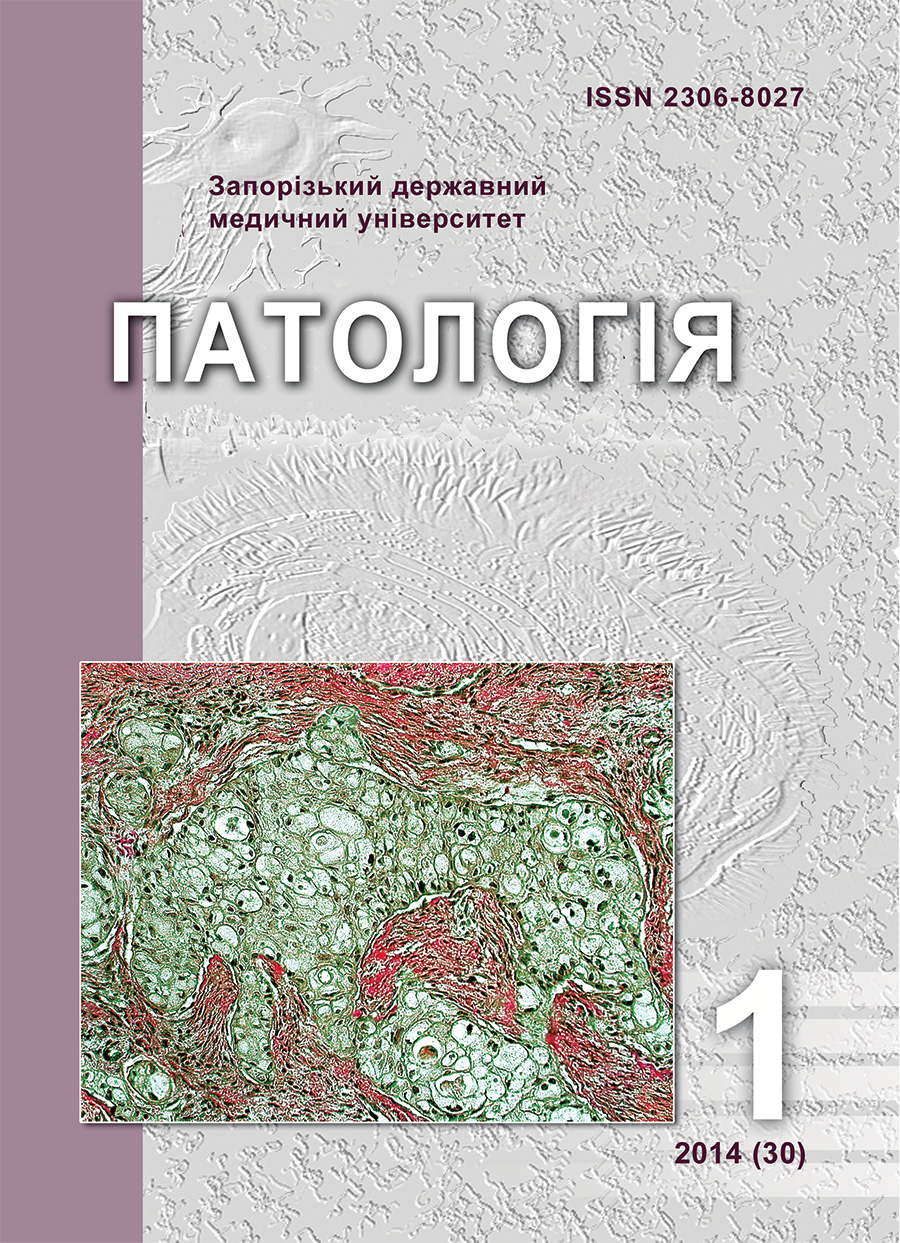Vimentin expression in the tumor cells of carcinomas of different organs and different histological types
DOI:
https://doi.org/10.14739/2310-1237.2014.1.25958Keywords:
epithelial-mesenhymal transition, stomach neoplasms, lung neoplasms, kidney neoplasmsAbstract
Aims. Epithelial- mesenсhymal transition endows tumors with such qualities as ability to invasion and metastasis development, prevents their apoptosis and ageing, promotes angiogenesis, immunosupression, resistance to chemo- and radiotherapy.
Methods and results. For the purpose of revealing complete epithelial-mesenchymal transition with expression of vimentin 24cases of gastric carcinoma, 46 cases of pulmonary carcinoma and 15 cases of renal cell carcinoma were studied immunohistochemicaly. Expression of vimentin was revealed more often in renal carcinomas (86,7%), adenocarcinomas of the lung (44,1%) and diffuse gastric carcinomas (80%). Authentically lower frequency expression of vimentin in intestinal gastric cancer (14,3%) and squamous cell and neuroendicrinal lung cancer (16.7%).
Conclusion. The expression of vementin may be connected with embrional histogenesis of organ, peculiarities of cancerogenesis and also with tumor progression.
References
Micalizzi, D. S., Farabaugh, S. M. & Ford, H. L. (2010) Epithelial-mesenchymal trnsition in cancer: parallels between normal development and tumor progresion. J. Mammary Gland Biol. Neoplasia, 15, 117–134. doi: 10.1007/s10911-010-9178-9.
Tun, H. W., Copland, J. A., Creighton, C., Anastasiadis, P. Z., Sinha, M., Luxon, B. A., et al. (2010). Pathway Signature and Cellular Differentiation in Clear Cell Renal Cell Carcinoma. PLoS ONE, 5(5), e10696. DOI: 10.1371/journal.pone.0010696.
Sato, M., Shames, D. S., & Hasegawa, Y. (2012). Emerging evidence of epithelial-to-mesenchymal transition in lung carcinogenesis. Respirology, 17(7), 1048–1059. doi: 10.1111/j.1440_1843.2012.02173.
Bermudez, O., Hennen, E., Koch, I., Lindner, M., Eickelberg, O., & Katoh, M. (2013). Gli1 Mediates Lung Cancer Cell Proliferation and Sonic Hedgehog-Dependent Mesenchymal Cell Activation. PLoS ONE, 8(5), e63226. doi: 10.1371/j.
Uhlenhaut, N. H., & Treier, M. (2008). Transcriptional regulators in kidney disease: gatekeepers of renal homeostasis. Trends in Genetics, 24(7), 361–371. doi: 10.1016/j.tig.2008.05.001.
Vasilenko, I. V., Sadchikov, V. D. & Galakhin, K. A. (2001) Predrak i rak zheludka: e`tiologoya, patogenez, morfologiya, lechebnyj patomorfoz [Precancer and cancer of stomach: etiology, pathogenesis, morphology, treatment pathomorphosis]. Kiev: Knigaplyus [in Ukrainian].
Kolesnik, A. P., Shevchenko, A. I., Tumanskij, V. A., Evseev, A. V. & Shishkin, M. A. (2013) Prognosticheskaya rol` e`kspressii receptorov k e`pidermal`nym faktoram rosta u bol`nykh s I–II stadiej nemelkokletochnogo raka legkogo [Prognostic role of expression receptor of epidermal growth factor in patients with I–II stage non-small cell lung carcinoma]. Pathologia, 2, 17–21.
Petrov, S. V. & Rajkhlin, N. T. (2012) Rukovodstvo po immunogistokhimicheskoj diagnostike opukholej cheloveka [Manual on immunohistochemical diagnostics of human tumours. 4-th edition]. Kazan [in Russian].
Prudkin, L., Moran, C., Bekele, B. N., Brown, K. C., Tang, X., Behrens, C., et al. (2009). Epithelial-to-mesenchymal transition in the development and progression of adenocarcinoma and squamous cell carcinoma of the lung.Modern Pathology, 22(5), 668–678.
Thierry, J. P., Acloque, H., Huang, R. Y. & Nieto, M. A. (2009) Epithelial-mesenchymal transition ns in development and disease. Cell., 139(5), 871–890.
König, K., Heukamp, L. C., Meder, L., Lawson, V., Buettner, R., Magin, T. M., et al. (2013). Loss of the Keratin Cytoskeleton Is Not Sufficient to Induce Epithelial Mesenchymal Transition in a Novel KRAS Driven Sporadic Lung Cancer Mouse Model. PLoS ONE, 8(3), e57996.
Dauphin, M., Barbe, C. & Lemaire, S. (2013) Vimentin expression predicts the occurence of metastases in non small cell lung cancinomas. Lung cancer, 8, 117–122.
Downloads
How to Cite
Issue
Section
License
Authors who publish with this journal agree to the following terms:
Authors retain copyright and grant the journal right of first publication with the work simultaneously licensed under a Creative Commons Attribution License that allows others to share the work with an acknowledgement of the work's authorship and initial publication in this journal.

Authors are able to enter into separate, additional contractual arrangements for the non-exclusive distribution of the journal's published version of the work (e.g., post it to an institutional repository or publish it in a book), with an acknowledgement of its initial publication in this journal.
Authors are permitted and encouraged to post their work online (e.g., in institutional repositories or on their website) prior to and during the submission process, as it can lead to productive exchanges, as well as earlier and greater citation of published work (SeeThe Effect of Open Access).

